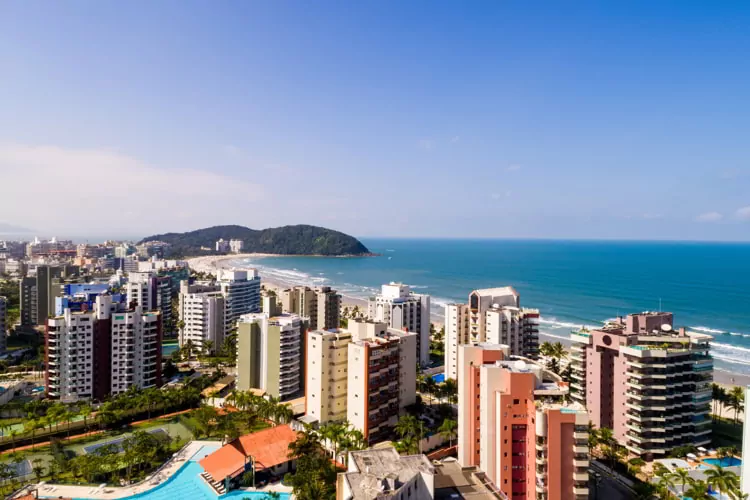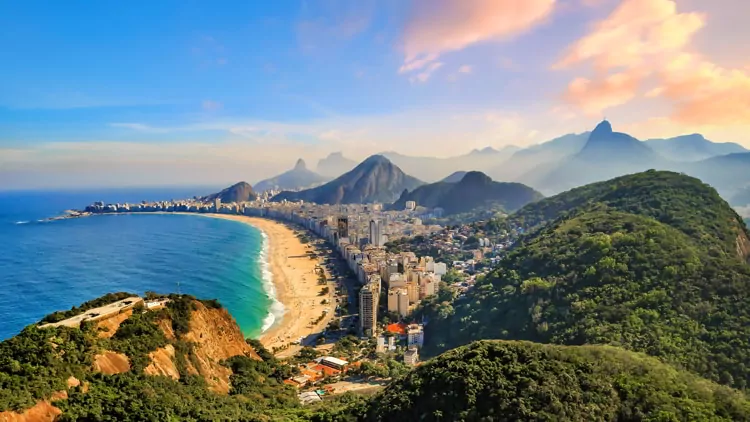Why Investors Are Flocking To Safe Haven Brazil
I’m not going to wax lyrical about the amazing natural beauty of Brazil, nor bore you with talk of 5,000 miles of coastline and many of the world’s best and most pristine beaches.
I won’t tell you about the rich and diverse culture, the 7 natural and 14 cultural UNESCO World Heritage Sites, or the rich music, cuisine, and exotic peoples either.
Today I’ll be analyzing the Brazilian economy, because Brazil has revealed herself as a safe haven investor’s paradise.
Everywhere else around the globe, markets are in turmoil, governments are panicking, and the world’s attention is turned toward the war in Ukraine.
Brazil doesn’t seem affected by any of this…
Savvy investor money is pouring into Brazil. And it’s easy to see why.
Brazil is the global powerhouse that is often forgotten, even though it’s one of the biggest, strongest, and most diversified economies in the world.
It’s also one of the most self-sufficient economies and is better insulated from the shock of world crises than nearly any other major economy.
Brazil is a gentle giant on the global stage and one we often overlook.
In times of turmoil investors seek safe havens for their money, and in global terms, Brazil is as safe as it gets while still offering opportunities for profit.
Here are some reasons why Brazil is an economic powerhouse:

1. Its size:
Brazil is vast. As the world’s fifth largest country by area, it’s only slightly smaller than the United States. Brazil borders every country in South America except Ecuador and Chile, making trade in Latin America exceptionally easy.
2. Population:
Brazil is the sixth most populous country on Earth, with a young population of 210 million that’s growing fast.
3. Economic strength:
Brazil’s economy is the 14th largest by GDP, with a GDP of US$1.45 trillion.
GDP comparisons are misleading. When you want to compare the size of economies that use different currencies, it’s better to use Purchasing Power Parity (PPP) to compare them.
PPP uses the price of a notional (pre-determined) basket of goods and services to show how much you can buy with the money you earn. About US$1,000 might get you a day’s work from a software developer in Southern California, but it’ll get you two weeks of labor from a tech whiz in Northern Brazil. Money goes a lot further in Brazil…
When PPP is used, the Brazilian economy is the seventh largest in the world with a relative buying power of about US$3 trillion.
4. Interest rates:
Brazil’s are the fourth highest in the world. They have recently increased to 12.75% in a move to dampen the inflation that is affecting many countries around the globe. This makes moving money into Brazilian bank accounts attractive to investors.
Anyone considering capitalizing on these attractive interest rates must factor the stronger real into their equation. Some of these high interest profits might be eaten away in U.S. dollar terms from a future softening of the real.
5. Diversified economy:
Brazil has an exceptionally diversified economy, with heavy and light industry, huge natural resource reserves, and a rapidly expanding services sector. None of these industries are heavily dependent on a single country, and Brazil has proven particularly insulated from the war in Ukraine.
6. No labor shortages:
Brazil’s unemployment rate stands at 14%, meaning there are no possibilities of inflationary pressures caused by labor shortages like we are seeing in the United States.
7. Commodity prices surging around the globe:
This benefits Brazil because it’s a huge producer of global commodities such as soy, iron, metal ores, sugar, oil, and agricultural produce. Even though Brazil is exposed to the rising costs of oil derivatives and some other raw materials, the general surge in global commodity prices that Brazil dominates more than compensates for the increases in these few categories.
8. Balance of trade surplus:
Brazil had a trade surplus in 2021 of US$61 billion. For a developing nation to enjoy such huge surpluses is uncommon and a strong indication of the general heath and diversity of its economy.
9. Foreign exchange gains:
The Brazilian real has appreciated quickly over the past few months and is the strongest it has been since March 2020.
10. Increased strength of the real:
It has increased in value from 5.57 to 4.75 reals to US$1 since the New Year. This big jump in value reflects investor confidence in the Brazilian economy compared to other countries. It’s a good sign that shows the economy is maturing.
While the real isn’t as cheap as it was just a few weeks ago, it’s still cheaper than it was for the seven years preceding 2019.
While this means you won’t get the U.S. dollar discount that was available to foreign investors for the past two years, you are enjoying the benefit of being able to buy into an economy that is more self-sufficient and better insulated than nearly every other developing economy in the world.
Even with this currency exchange rally, the real is still 20% cheaper than it was on March 1, 2019.
11. GDP growth:
Even with the effects of the pandemic on the economy, Brazil’s GDP grew by 5.1% in the year ending July 2021.
While GDP growth is expected to slow considerably this year due to the fallout of the various global economic crises, Brazil is projected to post 0.7% growth in 2022.
When you compare this year’s economic growth to negative growth of established economies of central Europe like Germany, you’ll realize that this is still a strong sign.
12. Agricultural exports:
Brazil is one of the biggest exporters of agricultural produce in the world, ranking fifth globally. The current global food crisis can be seen as a bonus for Brazil and her huge food producing industry.
13. Inflation situation:
The only black cloud on Brazil’s otherwise sunny investment horizon is the hefty 10% inflation rate it experienced this year. This is a direct effect of the rise in all prices due to global turmoil and pandemic pressures. The central bank has increased the interest rates to 12.5%-plus to combat this inflation and the moderating effects are already being felt.
A good way of beating inflation is to borrow money in the local currency and invest in real estate, as the value of the money you borrow decreases every year as it’s eroded by inflation.
14. Military:
Brazil has the second largest military in the Americas after the United States and has the largest military by amount of military equipment in the Southern Hemisphere. This means passive Brazil doesn’t have any fears of invasion or war, making Brazil exceptionally stable in Latin America.
The Property Market
Brazil’s property market is vast. It’s the fifth largest country in the world. It makes little sense to talk about the property market as a whole, though on average, property prices rose by 5.3% in 2021, even while dealing with the pandemic.
With mountains, plains, and coastal regions, it has a varied climate and landscape.
Price and quality also vary hugely depending on where you are and what you want to spend.
With its huge population, Brazil has a strong domestic demand from a rapidly growing middle class, and once you get outside the major cities, high-end property prices are a fraction what you’d pay in other countries.
It has thousands of miles of coastline where you can pick up beach houses for a pittance, but many of these areas are isolated or lack basic infrastructure.
Since the pandemic started, demand for houses outside cities has increased dramatically, and real estate continues to offer value and strong returns.
Attractive beach opportunities still exist in Brazil for the properly informed property investor.
Taxes In Brazil
Non-residents can own property in Brazil, and they enjoy a low rate of tax on any income, whether they hold the investment in their own names or through a company.
Brazil has a low tax rate, but it levies an extra 10% on people from low-tax countries.
Non-Residents
Rent and capital gains from property owned by non-resident persons are taxed at 15%.
Rent and capital gains from property owned by non-residents from low-tax countries are taxed at 25%.
Low-tax countries are those where the applicable income, business, or capital gains tax rate is less than 20%.
Brazil Tax Residents
When you become tax resident your tax rate increases with your income but it maxes out at 27.5%, which is about half the maximum tax rate of Ireland.
Property tax is 0.3% to 1% of the assessed value of the property.
Transaction costs are 9% to 14%, including agents fees of 5% to 6%.
Plummeting Mortgage Rates
Mortgage rates were 25% in 2002.
Today, 30-year flat mortgage rates are available at 6.99%, which is quite competitive for Latin America.
Recap On The Brazilian Economy
Brazil is the seventh largest economy in the world when Purchasing Power Parity is considered, the sixth most populous country in the world, the fifth largest country in the world by area, and the fifth largest agricultural exporter in the world.
It has the fourth highest interest rates for depositors and the second largest military in the Americas.
It’s possibly the most diversified economy, and it possesses some of the largest natural resource reserves in the world.
It’s no mystery why investors are flocking to the safe haven that is Brazil.
Con Murphy
Editor, Overseas Property Alert

